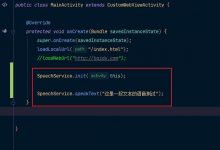今天给大家带来AnimatorSet的联合动画实现,因为疫情原因,高考推迟了一个月,明天就是2020年的高考了,祝各位考生都能上自己理想的学校
- 概述
- playTogether:
- playTogether结论:
- **得出结论:**
- 得出结论:
- 得出结论:
概述
什么是联合动画?
联合动画就是A执行完动画之后,B在执行动画,B执行完之后,C在执行.或者说ABC同时执行动画等
使用方法:
- playSequentially 逐个执行
public void playSequentially(Animator… items)
public void playSequentially(List items)
- playTogether 同时执行
public void playTogether (Animator… items)
public void playTogether (List items)
这两个有参构造方法很好理解,一个是可变参数,一个填的是List集合.
playTogether:
注意:
playTogether() 和 playSequentially() 不能一起使用,否则会没有效果;
ObjectAnimator tv1TranslationY = ObjectAnimator.ofFloat(tv1, \"translationY\", 0, 100, 300, 0);ObjectAnimator Tv1BackgroundColor = ObjectAnimator.ofInt(tv1, \"BackgroundColor\", 0xff00ff11, 0xff22ff11, 0xff000011, 0xff019f11);ObjectAnimator tv2TranslationY = ObjectAnimator.ofFloat(tv2, \"translationY\", 0, 100, 300, 0);AnimatorSet animatorSet = new AnimatorSet();//一起播放animatorSet.playTogether(tv1TranslationY,Tv1BackgroundColor,tv2TranslationY);animatorSet.setDuration(2000);animatorSet.start();
从代码中可以看出:
tv1,设置了颜色的变化以及先下平移的动画,tv2设置只设置了向下的平移,并且都执行2s,从效果图中可以看出,和咋们预想的完全一致:

ObjectAnimator tv1TranslationY = ObjectAnimator.ofFloat(tv1, \"translationY\", 0, 100, 300, 0);ObjectAnimator Tv1BackgroundColor = ObjectAnimator.ofInt(tv1, \"BackgroundColor\", 0xff00ff11, 0xff22ff11, 0xff000011, 0xff019f11);ObjectAnimator tv2TranslationY = ObjectAnimator.ofFloat(tv2, \"translationY\", 0, 100, 300, 0);tv1TranslationY.setDuration(3000);AnimatorSet animatorSet = new AnimatorSet();//一起播放animatorSet.playTogether(tv1TranslationY,Tv1BackgroundColor,tv2TranslationY);animatorSet.setDuration(2000);animatorSet.start();
还是上面的代码.只不过给tv1设置了3s的动画时间,现在在来看看效果:

可以从效果图中看出,并没有什么变化,由此得出结论:
- playTogether()不受其他动画时间的影响.
ObjectAnimator tv1TranslationY = ObjectAnimator.ofFloat(tv1, \"translationY\", 0, 100, 300, 0);ObjectAnimator Tv1BackgroundColor = ObjectAnimator.ofInt(tv1, \"BackgroundColor\", 0xff00ff11, 0xff22ff11, 0xff000011, 0xff019f11);ObjectAnimator tv2TranslationY = ObjectAnimator.ofFloat(tv2, \"translationY\", 0, 100, 300, 0);tv1TranslationY.setStartDelay(3000);//设置开始时间延长3stv1TranslationY.setDuration(3000);AnimatorSet animatorSet = new AnimatorSet();//一起播放animatorSet.playTogether(tv1TranslationY,Tv1BackgroundColor,tv2TranslationY);animatorSet.setDuration(2000);animatorSet.start();
本次又将开始的时间延长了3s,这次在看看会是什么效果:
从图中可以很明显的看出,将开始时间延长3s(setStartDelay(3000)),确实起作用了的出新结论:
setStartDelay()可以影响playTogether()的启动时间
ObjectAnimator tv1TranslationY = ObjectAnimator.ofFloat(tv1, \"translationY\", 0, 100, 300, 0);ObjectAnimator Tv1BackgroundColor = ObjectAnimator.ofInt(tv1, \"BackgroundColor\", 0xff00ff11, 0xff22ff11, 0xff000011, 0xff019f11);ObjectAnimator tv2TranslationY = ObjectAnimator.ofFloat(tv2, \"translationY\", 0, 100, 300, 0);tv1TranslationY.setStartDelay(3000);tv1TranslationY.setRepeatCount(ObjectAnimator.INFINITE);AnimatorSet animatorSet = new AnimatorSet();//一起播放animatorSet.playTogether(tv1TranslationY,Tv1BackgroundColor,tv2TranslationY);animatorSet.setDuration(2000);animatorSet.start();
本次又将tv1TranslationY设置了无限次数的重复,来看看效果他会不会一直重复呢?

从效果图冲可以看出,setRepeatCount也不受playTogether()的影响:
playTogether结论:
- playTogether()不受其他动画时间的影响.
- setStartDelay()可以影响playTogether()的启动时间
- setRepeatCount()不受playTogether()的影响
playSequentially
ObjectAnimator tv1TranslationY = ObjectAnimator.ofFloat(tv1, \"translationY\", 0, 100, 300, 0);ObjectAnimator Tv1BackgroundColor = ObjectAnimator.ofInt(tv1, \"BackgroundColor\", 0xff00ff11, 0xff22ff11, 0xff000011, 0xff019f11);ObjectAnimator tv2TranslationY = ObjectAnimator.ofFloat(tv2, \"translationY\", 0, 100, 300,AnimatorSet animatorSet = new AnimatorSet();//逐个播放animatorSet.playSequentially(tv1TranslationY,Tv1BackgroundColor,tv2TranslationY);animatorSet.setDuration(2000);animatorSet.start();
本次设置的是逐个播放,就是按顺序播放动画.

可以得出结论,执行的顺序就是
animatorSet.playSequentially(tv1TranslationY,Tv1BackgroundColor,tv2TranslationY);设置的顺序.
下一步还是按照上面测试playTogether()的方法测试playSequentially()
ObjectAnimator tv1TranslationY = ObjectAnimator.ofFloat(tv1, \"translationY\", 0, 100, 300, 0);ObjectAnimator Tv1BackgroundColor = ObjectAnimator.ofInt(tv1, \"BackgroundColor\", 0xff00ff11, 0xff22ff11, 0xff000011, 0xff019f11);ObjectAnimator tv2TranslationY = ObjectAnimator.ofFloat(tv2, \"translationY\", 0, 100, 300, 0);// tv1TranslationY.setStartDelay(3000);tv1TranslationY.setDuration(3000);AnimatorSet animatorSet = new AnimatorSet();//逐个播放animatorSet.playSequentially(tv1TranslationY,Tv1BackgroundColor,tv2TranslationY);animatorSet.setDuration(2000);animatorSet.start();
本次还是正常的设置,并且给tv1设置了3s的动画时间.

可以看出,playTogether()一样,并没有什么效果;
ObjectAnimator tv1TranslationY = ObjectAnimator.ofFloat(tv1, \"translationY\", 0, 100, 300, 0);ObjectAnimator Tv1BackgroundColor = ObjectAnimator.ofInt(tv1, \"BackgroundColor\", 0xff00ff11, 0xff22ff11, 0xff000011, 0xff019f11);ObjectAnimator tv2TranslationY = ObjectAnimator.ofFloat(tv2, \"translationY\", 0, 100, 300, 0);tv1TranslationY.setStartDelay(3000);AnimatorSet animatorSet = new AnimatorSet();//逐个播放animatorSet.playSequentially(tv1TranslationY,Tv1BackgroundColor,tv2TranslationY);animatorSet.setDuration(2000);animatorSet.start();
本次还是将tv1的开始时间延长3s

ObjectAnimator tv1TranslationY = ObjectAnimator.ofFloat(tv1, \"translationY\", 0, 100, 300, 0);ObjectAnimator Tv1BackgroundColor = ObjectAnimator.ofInt(tv1, \"BackgroundColor\", 0xff00ff11, 0xff22ff11, 0xff000011, 0xff019f11);ObjectAnimator tv2TranslationY = ObjectAnimator.ofFloat(tv2, \"translationY\", 0, 100, 300, 0);tv1TranslationY.setStartDelay(3000);tv1TranslationY.setRepeatCount(ObjectAnimator.INFINITE);// tv1TranslationY.setDuration(3000);AnimatorSet animatorSet = new AnimatorSet();//逐个播放animatorSet.playSequentially(Tv1BackgroundColor,tv1TranslationY,tv2TranslationY);animatorSet.setDuration(2000);animatorSet.start();
本次还是设置tv1TranslationY的setRepeatCount()为无限次数播放,来康康效果:

可以很清晰的看到先执行了tv1的颜色变化,然后停留了3s,执行了tv1的移动动画,tv2始终没有被执行到;
得出结论:
- playSequentially()的动画执行顺序是根据参数所执行的
- 设置动画时间会不起作用
- 延长动画时间起作用
- 若要给动画设置了无限次数执行的操作,则该操作后面的动画会执行不到,因为前面不执行完,后面没办法执行
animatorSet.setTarget()
设置ObjectAnimator动画目标控件
public void setTarget(Object target)
- playTogether:
ObjectAnimator tv1TranslationY = ObjectAnimator.ofFloat(tv1, \"translationX\", 0, 100, 300);ObjectAnimator Tv1BackgroundColor = ObjectAnimator.ofInt(tv1, \"BackgroundColor\", 0xff00ff11, 0xff22ff11, 0xff000011, 0xff019f11);ObjectAnimator tv2TranslationY = ObjectAnimator.ofFloat(tv2, \"translationY\", 0, 100, 300);AnimatorSet animatorSet = new AnimatorSet();//逐个播放animatorSet.playSequentially(Tv1BackgroundColor,tv1TranslationY,tv2TranslationY);animatorSet.setTarget(tv2);animatorSet.setDuration(2000);animatorSet.start();
将所有动画都给到tv2,包括tv1的X轴移动,颜色变化以及本身的Y轴移动,并依次播放,来看看效果吧:

playSequentially:
ObjectAnimator tv1TranslationY = ObjectAnimator.ofFloat(tv1, \"translationX\", 0, 100, 300);ObjectAnimator Tv1BackgroundColor = ObjectAnimator.ofInt(tv1, \"BackgroundColor\", 0xff00ff11, 0xff22ff11, 0xff000011, 0xff019f11);ObjectAnimator tv2TranslationY = ObjectAnimator.ofFloat(tv2, \"translationY\", 0, 100, 300);AnimatorSet animatorSet = new AnimatorSet();//逐个播放animatorSet.playSequentially(Tv1BackgroundColor,tv1TranslationY,tv2TranslationY);animatorSet.setTarget(tv2);animatorSet.setDuration(2000);animatorSet.start();
本次设置了逐个播放,给到了tv2控件,来看看效果吧:

可以看出,还是吧所以的动画都给到了tv2,并且依次播放
得出结论:
- 会同时把所有的动画效果都集中到一个控件’身上’,并且保留最后状态playTogether会同时播放playSequentially会逐个播放
AnimatorSet.Builder
//调用AnimatorSet中的play方法是获取AnimatorSet.Builder对象的唯一途径//表示要播放哪个动画public Builder play(Animator anim)表示一起执行的动画,不能after一起执行public Builder with(Animator anim)表示最后执行的动画,若有多个,多个一起执行public Builder before(Animator anim)表示最先执行的动画,若有多个,多个一起执行public Builder after(Animator anim)//延迟n毫秒之后执行动画public Builder after(long delay)动画执行优先级:after() > play() && with() > before()
ObjectAnimator tv1TranslationY = ObjectAnimator.ofFloat(tv1, \"translationY\", 0, 100, 300, 0);ObjectAnimator tv1BackgroundColor = ObjectAnimator.ofInt(tv1, \"BackgroundColor\", 0xff00ff11, 0xff22ff11, 0xff000011, 0xff019f11);ObjectAnimator tv2TranslationY = ObjectAnimator.ofFloat(tv2, \"translationY\", 0, 100, 300, 0);ObjectAnimator tv3TranslationY = ObjectAnimator.ofFloat(tv3, \"translationY\", 0, 100, 300, 0);AnimatorSet animatorSet = new AnimatorSet();AnimatorSet.Builder play = animatorSet.play(tv1TranslationY);play.before(tv2TranslationY).after(tv3TranslationY).with(tv1BackgroundColor);animatorSet.setDuration(3000);animatorSet.start();
从这行代码可以看出,应该是先执行tv3TranslationY的动画,紧接着执行tv1TranslationY和tv1BackgroundColor的动画,最后在执行tv2TranslationY的动画,来看看效果吧:
ObjectAnimator tv1TranslationY = ObjectAnimator.ofFloat(tv1, \"translationY\", 0, 100, 300, 0);ObjectAnimator tv1BackgroundColor = ObjectAnimator.ofInt(tv1, \"BackgroundColor\", 0xff00ff11, 0xff22ff11, 0xff000011, 0xff019f11);ObjectAnimator tv2TranslationY = ObjectAnimator.ofFloat(tv2, \"translationY\", 0, 100, 300, 0);ObjectAnimator tv3TranslationY = ObjectAnimator.ofFloat(tv3, \"translationY\", 0, 100, 300, 0);tv1TranslationY.setRepeatCount(-1);tv3TranslationY.setStartDelay(3000);AnimatorSet animatorSet = new AnimatorSet();AnimatorSet.Builder play = animatorSet.play(tv1TranslationY);play.before(tv2TranslationY).after(tv3TranslationY).with(tv1BackgroundColor);animatorSet.setDuration(3000);
本次给tv1设置了无限次数播放的操作,并且给tv3设置了延迟3s开启动画的操作,来看看效果吧:
可以看出,tv3 3s后执行了Y轴移动的动画,并且Tv1无限的执行;
得出结论:
- 延长动画时间起作用
- 若要给动画设置了无限次数执行的操作,则该操作后面的动画会执行不到,因为前面不执行完,后面没办法执行
参考文档: 启舰.
git地址:链接: langyangyang.
 爱站程序员基地
爱站程序员基地


